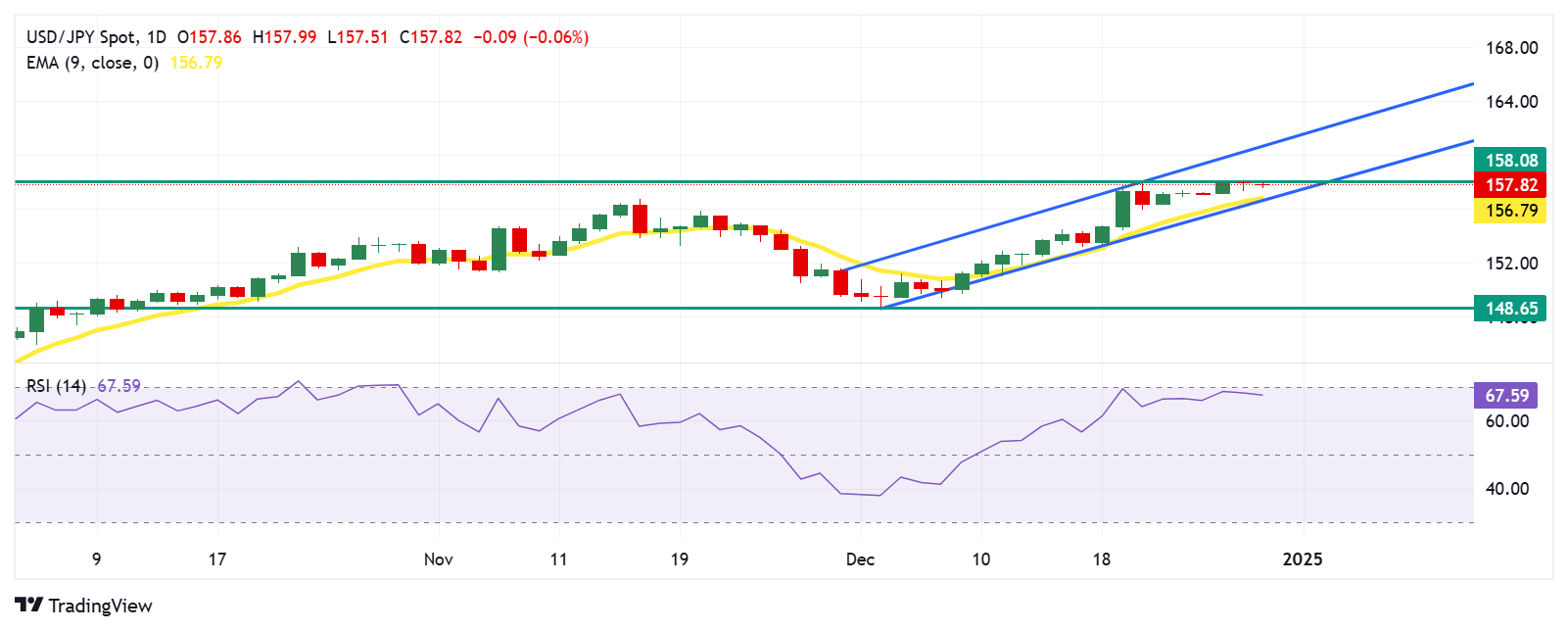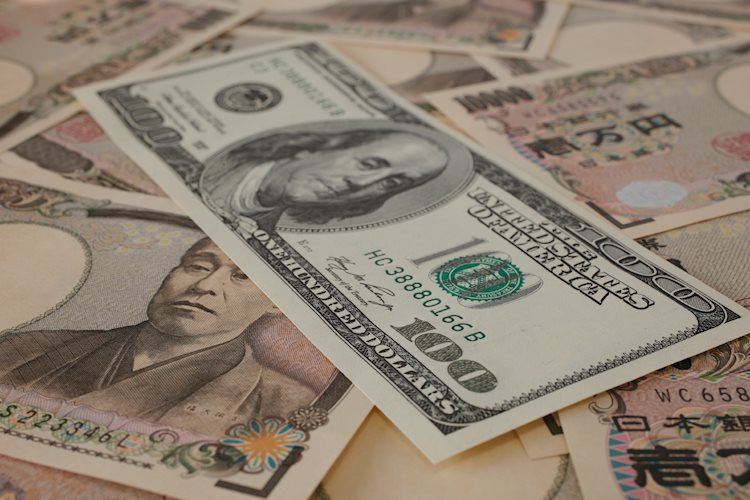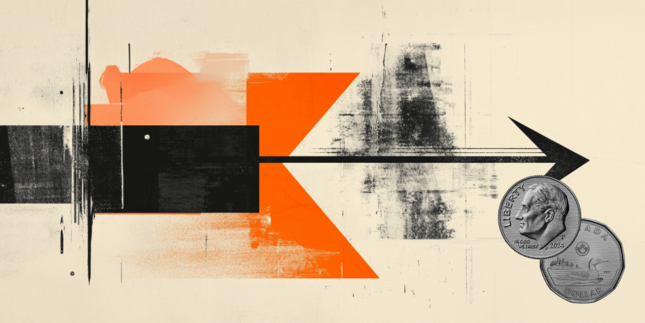Japanese Yen steadies against US Dollar amid thin trading ahead of New Year holiday
- The Japanese Yen holds ground as traders expect the BoJ to deliver an interest rate hike in January.
- Japan’s Jibun Bank Manufacturing PMI reached 49.6 in December, exceeding the expected 49.5 and prior 49.0 readings.
- The US Dollar remains subdued as US Treasury yields decline, with the 2- and 10-year at 4.32% and 4.62%, respectively.
The Japanese Yen (JPY) moves little against the US Dollar (USD) on Monday. The USD/JPY pair holds ground as the Japanese Yen (JPY) receives support from the market sentiment that the Bank of Japan (BoJ) may raise interest rates in January following the release of Tokyo Consumer Price Index (CPI) inflation data last week.
Japan’s Jibun Bank Manufacturing PMI reached 49.6 in December, slightly exceeding the flash estimate of 49.5 and improving from 49.0 in November. Although it marked the highest level since September, it still signaled the sixth consecutive month of declining factory activity.
The Nikkei 225 fell to around 39,950 on Monday, snapping two days of gains. The decline came after a slight drop in US futures, following Friday's Wall Street slump driven by rising Treasury yields and indications of more restrained interest rate cuts in 2025.
Japanese Yen holds ground as US Dollar remains subdued as Treasury yields depreciate
- The US Dollar Index (DXY), which measures the value of the US Dollar (USD) against its six major peers, trades around 108.00. The Greenback faces challenges as US Treasury bond yields depreciate on Monday. 2-year and 10-year yields stand at 4.30% and 4.59%, respectively, at the time of writing.
- The US Dollar may gain support from growing expectations of fewer rate cuts next year by the US Federal Reserve (Fed). Traders continue to digest the Fed’s hawkish pivot. The Fed cut its benchmark interest rate by a quarter point at the December meeting, and the latest Dot Plots indicated two rate cuts next year.
- The headline Tokyo CPI inflation rose to 3.0% YoY in December, up from 2.6% in November. Meanwhile, the Tokyo CPI excluding Fresh Food and Energy increased to 2.4% YoY in December, compared to 2.2% the previous month. The Tokyo CPI excluding Fresh Food also climbed 2.4% YoY in December, slightly below the expected 2.5% but higher than the 2.2% recorded in November.
- On Friday, Japan's Finance Minister Katsunobu Kato said that he recently saw one-sided and sharp foreign exchange (FX) moves. Kato further stated that the official will take suitable measures against excessive foreign exchange movements.
- The Bank of Japan (BoJ) released the Summary of Opinions from its December monetary policy meeting on Friday, highlighting plans to adjust easing measures if economic conditions align with expectations. One BoJ board member emphasized the importance of monitoring wage negotiation momentum, while another stressed the need for scrutiny of data to determine any changes to monetary support.
- The Bank of Japan October meeting Minutes released this Tuesday reiterated the possibility of gradual rate hikes if inflation trends align with expectations, with a potential path to 1.0% by late fiscal 2025. The Minutes also emphasized a cautious approach to monetary policy, wage-driven economic growth amid domestic and global uncertainties, and fiscal measures to counter deflationary pressures.
- Earlier in the month, BoJ Governor Kazuo Ueda said that the central bank expects the Japanese economy to move closer to sustainably achieving the BoJ's 2% inflation target next year. Ueda also added, "The timing and pace of adjusting the degree of monetary accommodation will depend on developments in economic activity and prices as well as financial conditions going forward."
Technical Analysis: USD/JPY remains subdued below monthly highs near 158.00
The USD/JPY pair trades near 157.80 on Monday, maintaining its bullish momentum within an ascending channel on the daily chart. The 14-day Relative Strength Index (RSI) hovers just below the 70 level, supporting the bullish trend. However, if the RSI surpasses the 70 mark, it could indicate an overbought condition, potentially triggering a downward correction.
On the upside, the USD/JPY pair may retest its monthly high of 158.08, reached on December 26. A decisive break above this level could pave the way for further gains, with the pair potentially targeting the ascending channel’s upper boundary near 160.60.
The immediate support lies at the nine-day Exponential Moving Average (EMA) around 156.79, closely aligned with the ascending channel's lower boundary near 156.50.
USD/JPY: Daily Chart

(This story was corrected on December 30 at 08:00 GMT to say, in the Title, pre-New Year light trading instead of post-New Year.)
Japanese Yen PRICE Today
The table below shows the percentage change of Japanese Yen (JPY) against listed major currencies today. Japanese Yen was the strongest against the Swiss Franc.
| USD | EUR | GBP | JPY | CAD | AUD | NZD | CHF | |
|---|---|---|---|---|---|---|---|---|
| USD | 0.11% | 0.09% | 0.11% | -0.06% | -0.10% | -0.36% | 0.25% | |
| EUR | -0.11% | -0.02% | -0.05% | -0.22% | -0.28% | -0.50% | 0.09% | |
| GBP | -0.09% | 0.02% | -0.02% | -0.20% | -0.26% | -0.47% | 0.11% | |
| JPY | -0.11% | 0.05% | 0.02% | -0.18% | -0.16% | -0.31% | 0.17% | |
| CAD | 0.06% | 0.22% | 0.20% | 0.18% | -0.03% | -0.22% | 0.31% | |
| AUD | 0.10% | 0.28% | 0.26% | 0.16% | 0.03% | -0.23% | 0.37% | |
| NZD | 0.36% | 0.50% | 0.47% | 0.31% | 0.22% | 0.23% | 0.60% | |
| CHF | -0.25% | -0.09% | -0.11% | -0.17% | -0.31% | -0.37% | -0.60% |
The heat map shows percentage changes of major currencies against each other. The base currency is picked from the left column, while the quote currency is picked from the top row. For example, if you pick the Japanese Yen from the left column and move along the horizontal line to the US Dollar, the percentage change displayed in the box will represent JPY (base)/USD (quote).
Japanese Yen FAQs
The Japanese Yen (JPY) is one of the world’s most traded currencies. Its value is broadly determined by the performance of the Japanese economy, but more specifically by the Bank of Japan’s policy, the differential between Japanese and US bond yields, or risk sentiment among traders, among other factors.
One of the Bank of Japan’s mandates is currency control, so its moves are key for the Yen. The BoJ has directly intervened in currency markets sometimes, generally to lower the value of the Yen, although it refrains from doing it often due to political concerns of its main trading partners. The BoJ ultra-loose monetary policy between 2013 and 2024 caused the Yen to depreciate against its main currency peers due to an increasing policy divergence between the Bank of Japan and other main central banks. More recently, the gradually unwinding of this ultra-loose policy has given some support to the Yen.
Over the last decade, the BoJ’s stance of sticking to ultra-loose monetary policy has led to a widening policy divergence with other central banks, particularly with the US Federal Reserve. This supported a widening of the differential between the 10-year US and Japanese bonds, which favored the US Dollar against the Japanese Yen. The BoJ decision in 2024 to gradually abandon the ultra-loose policy, coupled with interest-rate cuts in other major central banks, is narrowing this differential.
The Japanese Yen is often seen as a safe-haven investment. This means that in times of market stress, investors are more likely to put their money in the Japanese currency due to its supposed reliability and stability. Turbulent times are likely to strengthen the Yen’s value against other currencies seen as more risky to invest in.
Forex News
Keep up with the financial markets, know what's happening and what is affecting the markets with our latest market updates. Analyze market movers, trends and build your trading strategies accordingly.





















